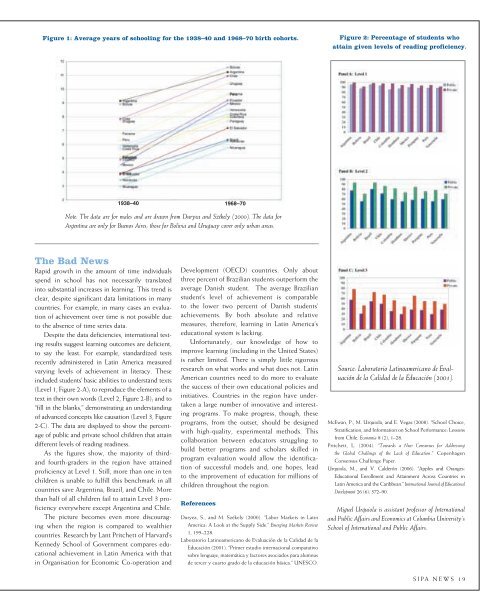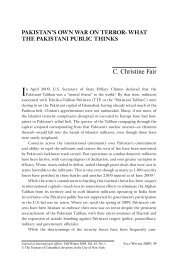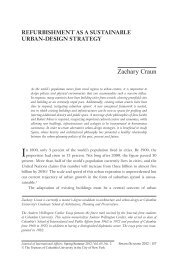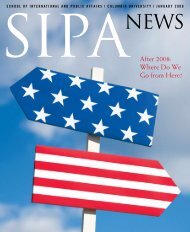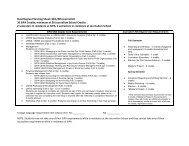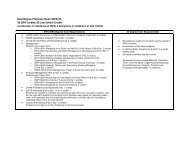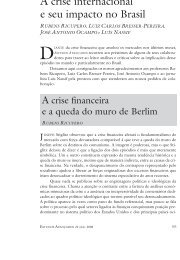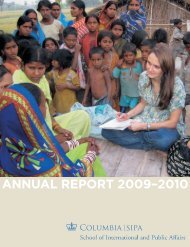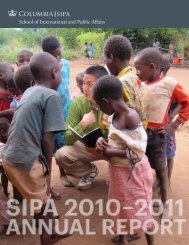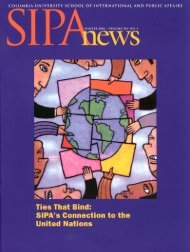SIPANEWS - SIPA - Columbia University
SIPANEWS - SIPA - Columbia University
SIPANEWS - SIPA - Columbia University
Create successful ePaper yourself
Turn your PDF publications into a flip-book with our unique Google optimized e-Paper software.
Figure 1: Average years of schooling for the 1938–40 and 1968–70 birth cohorts.<br />
The Bad News<br />
Rapid growth in the amount of time individuals<br />
spend in school has not necessarily translated<br />
into substantial increases in learning. This trend is<br />
clear, despite significant data limitations in many<br />
countries. For example, in many cases an evaluation<br />
of achievement over time is not possible due<br />
to the absence of time series data.<br />
Despite the data deficiencies, international testing<br />
results suggest learning outcomes are deficient,<br />
to say the least. For example, standardized tests<br />
recently administered in Latin America measured<br />
varying levels of achievement in literacy. These<br />
included students’ basic abilities to understand texts<br />
(Level 1, Figure 2-A); to reproduce the elements of a<br />
text in their own words (Level 2, Figure 2-B); and to<br />
“fill in the blanks,” demonstrating an understanding<br />
of advanced concepts like causation (Level 3, Figure<br />
2-C). The data are displayed to show the percentage<br />
of public and private school children that attain<br />
different levels of reading readiness.<br />
As the figures show, the majority of third-<br />
and fourth-graders in the region have attained<br />
proficiency at Level 1. Still, more than one in ten<br />
children is unable to fulfill this benchmark in all<br />
countries save Argentina, Brazil, and Chile. More<br />
than half of all children fail to attain Level 3 proficiency<br />
everywhere except Argentina and Chile.<br />
The picture becomes even more discouraging<br />
when the region is compared to wealthier<br />
countries. Research by Lant Pritchett of Harvard’s<br />
Kennedy School of Government compares educational<br />
achievement in Latin America with that<br />
in Organisation for Economic Co-operation and<br />
1938–40 1968–70<br />
Note: The data are for males and are drawn from Duryea and Székely (2000). The data for<br />
Argentina are only for Buenos Aires; those for Bolivia and Uruguay cover only urban areas.<br />
Development (OECD) countries. Only about<br />
three percent of Brazilian students outperform the<br />
average Danish student. The average Brazilian<br />
student’s level of achievement is comparable<br />
to the lower two percent of Danish students’<br />
achievements. By both absolute and relative<br />
measures, therefore, learning in Latin America’s<br />
educational system is lacking.<br />
Unfortunately, our knowledge of how to<br />
improve learning (including in the United States)<br />
is rather limited. There is simply little rigorous<br />
research on what works and what does not. Latin<br />
American countries need to do more to evaluate<br />
the success of their own educational policies and<br />
initiatives. Countries in the region have undertaken<br />
a large number of innovative and interesting<br />
programs. To make progress, though, these<br />
programs, from the outset, should be designed<br />
with high-quality, experimental methods. This<br />
collaboration between educators struggling to<br />
build better programs and scholars skilled in<br />
program evaluation would allow the identification<br />
of successful models and, one hopes, lead<br />
to the improvement of education for millions of<br />
children throughout the region.<br />
References<br />
Duryea, S., and M. Székely (2000). “Labor Markets in Latin<br />
America: A Look at the Supply Side.” Emerging Markets Review<br />
1, 199–228.<br />
Laboratorio Latinoamericano de Evaluación de la Calidad de la<br />
Educación (2001). “Primer estudio internacional comparativo<br />
sobre lenguaje, matemática y factores asociados para alumnus<br />
de tercer y cuarto grado de la educación básica.” UNESCO.<br />
Figure 2: Percentage of students who<br />
attain given levels of reading proficiency.<br />
Source: Laboratorio Latinoamericano de Evaluación<br />
de la Calidad de la Educación (2001).<br />
McEwan, P., M. Urquiola, and E. Vegas (2008). “School Choice,<br />
Stratification, and Information on School Performance: Lessons<br />
from Chile. Economia 8 (2), 1–28.<br />
Pritchett, L. (2004). “Towards a New Consensus for Addressing<br />
the Global Challenge of the Lack of Education.” Copenhagen<br />
Consensus Challenge Paper.<br />
Urquiola, M., and V. Calderón (2006). “Apples and Oranges:<br />
Educational Enrollment and Attainment Across Countries in<br />
Latin America and the Caribbean.” International Journal of Educational<br />
Development 26 (6): 572–90.<br />
Miguel Urquiola is assistant professor of International<br />
and Public Affairs and Economics at <strong>Columbia</strong> <strong>University</strong>’s<br />
School of International and Public Affairs.<br />
<strong>SIPA</strong> NEWS 19


